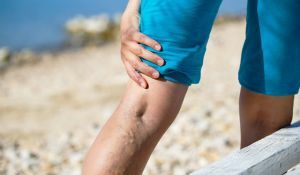 The blood circulation in the body is as follows: the blood is absorbed in the heart, and then it is repelled by the body through the blood-sucking vessels. The strength of the heart beat is such that it spreads to the periphery without loss.
The blood circulation in the body is as follows: the blood is absorbed in the heart, and then it is repelled by the body through the blood-sucking vessels. The strength of the heart beat is such that it spreads to the periphery without loss.
Vessels and the heart form a closed system in which a certain pressure is maintained. Optimal it is regulated by the influence of the nervous system, which reacts to emotions arising in man.
There are no arteries or veins on the periphery - there are capillaries with a wall so thin and lumen so small that red blood cells literally squeeze through it. At the time of contact of the surface of the erythrocyte with the wall of the capillary, there is an exchange: erythrocytes are "unloaded" from oxygen and substances for feeding tissues, "loaded" with toxic substances carried by the blood to the organs of the purification systems.
In both directions from the capillary network, not only the lumen of the vessels changes - the closer to the heart, the wider, but there are also signs that divide the blood-sucking organs into two types: in the wall of the arteries - the muscular "armature", in the walls of the veins - valves to block the flowblood down.
The main function of blood vessels is transport of blood: along the arteries to the organs, through the veins into the cardiac cavities.
In accordance with the structure of the vascular wall of the disease, it is tested, will be different: for the arteries - atrophy of the muscular structures and overgrowth of the lumen, for the veins - stretching in breadth with the ensuing consequences.
Contents
- Leg vessels as a separate topic
- Varicose veins
- Phlebitis and thrombophlebitis - dangerous venous leg diseases
- Arteritis obliterates
- Symptoms and treatment of atherosclerosis of the leg vessels
- Diagnosis and treatment
- Diagnostic methods and treatment concept
- Folk treatment
- From varices
- Fromatherosclerosis of the arteries of the feet
- About the prevention of vascular problems
Leg vessels as a separate topic
The peculiarity of the legs is their location - they are distanced fromrdtsa on as long distance. The second is the 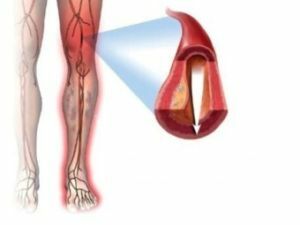 need to raise the blood from them from the bottom up, counteracting the force of gravity.
need to raise the blood from them from the bottom up, counteracting the force of gravity.
And still the legs are the support organs, which must withstand the force of the whole mass of the body pressing on them. Therefore, their vessels should have a more powerful development than the analogous organs of the hands, be maximally trained both for the support and for maintaining the load increasing with movements.
Hence the list of causes of diseases common to both veins and arteries of the legs. It includes a small degree of involvement of the lower limbs with:
- excess body weight;
- a way of life with a low degree of mobility;
- lifestyle is excessively active, with extreme strain on the legs, also can lead to damage to the vascular wall, this is: exercise with exercise;labor with lifting heavy weights;work with a long standing on the legs.
Toxicants, chronic and frequently occurring acute infections and allergies are also of great importance.
Both redundancy and insufficiency of vascular tone is often due to chronic stress and diseases of the nervous system.
Separately, mention should be made of the cause, the particular for veins - the genetic determinant for varicose veins, for diseases with the pathology of blood coagulability, for endocrine diseases.
Lower limb vessels diseases:
- vein diseases in the form of their varicose veins, phlebitis and thrombophlebitis;
- arteries disease category of obliterating arteritis, thrombangiitis and arteriosclerosis of vessels.
Varicose veins
In case of varicose veins, the walls of the veins on the legs are unevenly stretched, causing the appearance of the typical tortuosity of their beds and the formation of "rosaries" under the subcutaneous location.
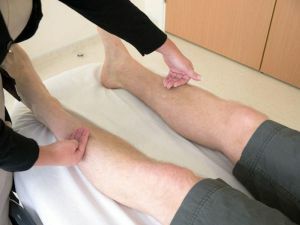 But pathology cosmetic defect is not limited - varicose seriously complicates the supply of blood to the tissues of the lower limbs, as well as blood circulation in the body as a whole, leading to increasing venous insufficiency.
But pathology cosmetic defect is not limited - varicose seriously complicates the supply of blood to the tissues of the lower limbs, as well as blood circulation in the body as a whole, leading to increasing venous insufficiency.
And with the transition to each next stage, the symptoms of the disease will increase: from a minor first swelling of the subcutaneous veins of the legs to almost complete stagnation of blood in them, from small swelling and unpleasant skin sensations to complete loss of sensitivity of individual skin areas, from mild hyperemia to completethe destruction of the skin in this part of the body with the formation of non-healing trophic ulcers.
External varicose disease is not limited - it develops in parallel in the pelvic organs, on the esophagus, in the veins of the head-neck system.
Phlebitis and thrombophlebitis - dangerous venous leg diseases
Sometimes the vein wall is not just stretched, but really inflames, leading to the development of phlebitis.
Symptoms of this disease of lower limb vessels will be as local:
- greater or less soreness;
- hyperemia and increased skin temperature over the site of venous inflammation.
So common in the form of
- chills;
- temperature rise;
- weakness and varying degrees of malaise in the form of a headache;
- of palsy and the like.
The very affected vein looks like a tightly dense red stripe - a painful crook stretched out under the skin along the limb, 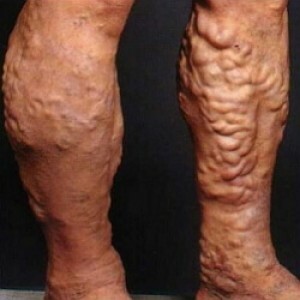 , the tension of the skin when the foot moves painfully exacerbates the pain.
, the tension of the skin when the foot moves painfully exacerbates the pain.
In the case of inflammation of the deep vein of the limb, the local picture will be dull, in the form of blurred puffiness, focal deep soreness, the skin itself will be without signs of condensation and will acquire a milky white shade.
Phlebitis does not necessarily have to be of the sharpest character, it often becomes chronic, proceeding less violently.
Due to mandatory endothelial damage in phlebitis, the risk of developing thrombophlebitis is high.
Then the phlebitis picture is overlaid with signs of a vein blockage. It can be complete or partial. But it is always physically palpable in the form of a malaise accompanying a subfebrile condition.
Locally, the blockage is manifested by the following symptoms:
- pain along the vein, worsening with limb movements;
- swelling of the leg, noticeable when compared with a healthy leg;
- by the presence of significantly painful cord-like seals-infiltrates, clearly palpable in the subcutaneous varicose veins;
- the skin over the foci is markedly hyperemic, with a hint of cyanosis, glistening, swollen and painful, warm to the touch.
Sharp edema of the limb should suggest an acute thrombophlebitis of the deep veins.
With this disease, body temperature suddenly rises to 39-39.5 ° C, with fits of chills, headache, dizziness and palpitations, an inadequate degree of temperature rise. Pain in the extremities is both an independent character, and intensify with coughing.
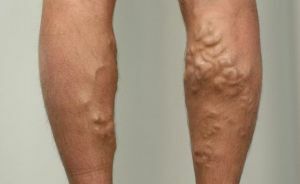 In addition to the sharp edema of the limb, the skin-like appearance of the skin attracts attention. She is sharply tense, pale, with a marble cyanotic pattern, and - cold.
In addition to the sharp edema of the limb, the skin-like appearance of the skin attracts attention. She is sharply tense, pale, with a marble cyanotic pattern, and - cold.
Appearance of "behind-the-scenes" pain caused by palpation of the internal calcaneus ankle region is just as characteristic as painfulness when squeezing the calf muscle and flexing the foot to the rear.
On the affected side there is a weakening of the pulse up to complete disappearance and an increase in regional lymph nodes with not a sharp pain. The disease is rarely cured, often becoming chronic.
The phlebitis of the upper extremities can be of a nature both infectious-toxic and be the result of medical manipulations with veins.
Arteritis obliterates
To obliterating endarteritis - the defeat of the arteries of the lower extremities "continuous mass" leads to excessive smoking, for this reason the number of lame and walking on one leg of men is steadily increasing.
Diseases of the arteries of the legs are expressed by other symptoms:
- acute one- or bilateral pain in the gastrocnemius;
- development in the legs of seizures;
- freezing and chilliness of limbs, even in a warm room;
- appearance and growth of "intermittent claudication" with the need for rest during walking;
- worsening skin trophism with the advent of deep cracks and non-healing ulcers.
Symptoms and treatment of atherosclerosis of the vessels of the legs
Unlike the previous disease with atherosclerosis of the arteries of the lower limbs, the obstruction to the blood flow is created by deposits on the inner wall of the vessels - first cholesterol, then encrusted with lime.
The causes of the violation are not only smoking in tobacco and alcoholism in its chronic form, not only in the addiction to 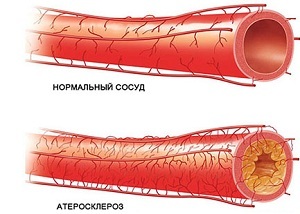 caffeine in the form of coffee and strong tea, but also in:
caffeine in the form of coffee and strong tea, but also in:
- food habits - in the abuse of foods rich in fats with easy and quick digestibility,leading to a disorder of cholesterol metabolism;
- work associated with frequent hypothermia of the feet, especially - stop.
No less important role is played by the patient's presence of arterial hypertension - hypertensive disease and diabetes mellitus.
In addition to the narrowing of the lumen and loss of elasticity, the inability of the artery wall to contractions develops due to the irreversible atrophy of the muscular layer.
All this together leads to the emergence and growth in the feet of the feeling:
- chilliness below the knees in any weather and in any setting;
- numbness and "ant creeping";
- pain in the lower legs first with walking, and then at rest.
There is a change in the appearance and structure of the skin: pale and cold at first it gradually loses the hair growing on it and the muscle volume - the diameter of the shins decreases, and then the skin becomes cold-hyperemic and swollen.
Diagnosis and treatment
In the diagnosis of atherosclerosis of the arteries of the lower limbs, everything is important. From a thorough "investigation" of the patient's way of life and determination of the pulse characteristics by applying a finger in the classical points for the limb to laboratory and instrumental methods of studying his vessels.
Performed using methods:
- rheovasography and angiography;
- duplex scanning of vessels and dopplerography;
- capillaroscopy;
- decoding of the lipid spectrum of blood and studying the indices of the blood coagulation system.
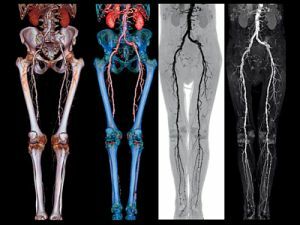 Treatment of atherosclerosis of the vessels of the lower extremities includes both measures for the treatment of the disease in general, and aimed at fighting its especially private manifestations - with lipid-calcium complexes. Prevention of thrombosis and restoration of blood flow in the bowels of these areas are also included in the task of medical action.
Treatment of atherosclerosis of the vessels of the lower extremities includes both measures for the treatment of the disease in general, and aimed at fighting its especially private manifestations - with lipid-calcium complexes. Prevention of thrombosis and restoration of blood flow in the bowels of these areas are also included in the task of medical action.
But without a radical solution to the issue of diet and lifestyle, therapeutic measures will give effect weak and short-lived. Therefore, participation in the rehabilitation program of a nutritionist is mandatory.
After careful examination, the patient is prescribed a mandatory home admission:
- Atorvastatin or Atoris , which prevents the deposition of cholesterol on the arterial walls;
- Aspirin or Cardiomagnesium -Anticoagulants.
In addition, regular regular at least twice a year intravenous infusions of Actovegin, Trental, courses of treatment with nicotinic acid, if necessary with Heparin, are strongly recommended.
Methods of surgical treatment of atherosclerosis of the vessels of the lower extremities:
- endarterectomy - cleaning the artery wall from narrowing its sclerotic plaques;
- stenting - forced expansion of the narrowing sites with the installation of an artificial frame-stent;
- bypass - creating a roundabout path for blood flow;
- replacement of the artery by the prosthesis .
Diagnostic methods and the concept of treatment
As with any vascular pathology, if any, the lower extremities are applicable to research methods using:
- radiopaque substances;
- ultrasound( UZGD);
- angiography;
- dopplerography;
- duplex scanning;
- multispiral computed tomography.
Therapeutic treatment of the vessels of the lower extremities aims:
- restoration of the rheological properties of the blood - decrease in its viscosity by the use of disaggregants: Aspirin, Heparin, often ignored Hirudin and other agents;

- restoration of vessel wall damage using various angioprotectants from Ascorbic acid and Troxevasin to NSAIDs and glucocorticoids;
- increase of the vascular tone to the state of qualitative blood circulation in the limb, adequate to the needs of its structures, both by electrophysiological( physiotherapy, massage, exercise therapy) and psychotherapeutic effects.
If necessary, the restoration of blood circulation in this part of the body is achieved by forced surgical treatment.
Folk remedies
Folk remedies and prescriptions for the treatment of diseases of the vessels of the lower extremities are numerous and varied, have varying degrees of effectiveness, but their application requires obligatory coordination with a phlebologist, angiologist, or surgeon. In any situation, the leading role they can not play, and are applicable only as an auxiliary tool.
From varicose
To prepare nettle tea, pour a glass of boiling water a pinch of dried grass, insist an hour;drink the infusion during the day, dividing into 3 doses;course - half a year, with a break of 2 weeks at the end of each month.
For a garlic compress, garlic is required in a white husk, which, after being cleaned and ground, is mixed with twice the volume of butter. The finished composition is superimposed on the problem areas of the veins at night.
For garlic-honey infusions, it is necessary, mixing 350 g of honey and 250 g of peeled chopped garlic and insisting a composition of 2 weeks, take it with tablespoons three times a day - one 40 minutes before meals within one to two months.
From atherosclerosis of the arteries of the feet
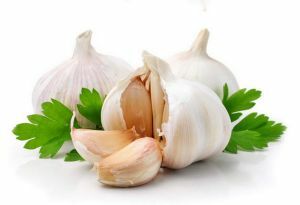 Garlic in the amount of 50 grams, after cleaning and crushing in a mortar to gruel, fill 1 glass of vodka, stand for 1 week in a dark place( not in the refrigerator), shaking methodically. Take 10 drops of water diluted with water three times a day. After a two-month break, the course is repeated.
Garlic in the amount of 50 grams, after cleaning and crushing in a mortar to gruel, fill 1 glass of vodka, stand for 1 week in a dark place( not in the refrigerator), shaking methodically. Take 10 drops of water diluted with water three times a day. After a two-month break, the course is repeated.
To get rid of excess cholesterol use the roots of dandelions, which, after drying and grinding, use, taking 1 teaspoon before each meal for six months.
On the prevention of vascular problems
If the way of life has become stress, and the method by which to protect the room and room existence with eating weight of the body, or, conversely, "running into" sports and other gambling moves, you can say goodbye to vascular health.
Only measured not sluggish, but also not convulsive rhythm of a life with necessary quantity of movement, meal and loading on nervous system is capable to keep them to a deep old age.
If there are even minor unpleasant sensations in the legs, you should undergo diagnostic tests, appointed by a specialist doctor - phlebologist or surgeon.
